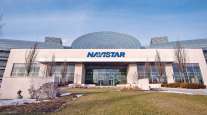Navistar CEO Cites Gains
This story appears in the July 14 print edition of Transport Topics.
WASHINGTON — Nearly two years into the rebuilding of Navistar International Corp., CEO Troy Clarke has slashed expenses, reduced employment rolls, closed unnecessary divisions and streamlined purchasing and production in order to return the original equipment manufacturer to profitability.
And, in an interview here with Transport Topics editors and reporters, he made clear that he and his managers still have more ground to cover.
Although financial losses persist for the Lisle, Illinois-based truck maker, its U.S. heavy-duty market share appears to have hit bottom in 2013 and has been growing this year, according to WardsAuto.com data. Clarke said he expects growth in sales volume and market share at least through 2015.
If and when Clarke finishes his restructuring — six-month net loss through April 30 was $545 million — the manufacturer might continue to stand alone or it could be purchased by another company, he said.
“The things we do to become successful as a North American stand-alone company would also make us a better partner,” Clarke said during the interview July 9. He said there are “a half-dozen folks” who might be interested in purchasing a reinvigorated Navistar, referring to truck manufacturers worldwide.
Although Clarke said he frequently fields calls from investment bankers, for now there is no plan to change ownership. The company’s history dates to 1831.
Clarke got the company’s top job in April 2013 and, before that, had been its chief operating officer since August 2012, when former CEO Daniel Ustian left suddenly in the wake of his decision to use truck-engine technology that led to a stream of losses.
Navistar lost $898 million in its fiscal 2013, down from $3.01 billion in fiscal 2012, which was Ustian’s last year.
The ripples of Ustian’s exhaust gas recirculation strategy are still felt at Navistar, even though Clarke and Lewis Campbell, interim CEO in 2012 and 2013, dropped EGR in favor of selective catalytic reduction diesel engines for Navistar’s Class 8 trucks.
The company has the capacity to spend $600 million to $700 million a year to satisfy warranty claims by using a balance-sheet reserve of $1.38 billion dedicated to warranty work. Navistar’s spending on warranty work during the February-to-April fiscal quarter was $23 million.
The 2010-2012 generation of EGR engines, however, has generated civil litigation, with a
Dallas-based law firm announcing three lawsuits against Navistar filed July 8 by trucking companies in Tennessee, Texas and Washington state.
“Until yesterday, I think we were doing pretty well,” Clarke said of his customer-satisfaction efforts. “I can’t say there’s not been litigation against us, but it hasn’t been a lot.”
Clarke said the company’s “liberal” warranty policy sides with customers if a claim is at least close. “We break a lot of ties in favor of the customer,” he said.
Clarke and his lieutenants, including Chief Operating Officer Jack Allen and North American Truck President Bill Kozek, have the complex task of improving financial controls and truck quality simultaneously. Clarke said the task is made somewhat easier by expansion in the North American truck market.
“All indicators now are kind of pointing in the right direction. Good things are happening,” Clarke said of demand for heavy- and medium-duty trucks.
Navistar’s U.S. heavy-duty market share fell to 14.4% in 2013, Ward’s said. During the first five months of this year, it’s up to 15.3%.
From 2008 through 2011, four years of poor sales industrywide, market share ranged from 21% to 28%. During three years of industry robustness, 2004-2006, Navistar had an average share of 18.5%, Ward’s said.
“We had to reinvigorate quality,” Clarke said, because in the long run, fleets will not pay well in excess of $100,000 per Class 8 tractor if it’s poorly made.
Noting that Navistar had “disappointed some customers who made other decisions,” Clarke stated, “We’re making the best trucks we’ve ever made now.”
Clarke said he started by changing Navistar’s basic structure.
“We used to be a bunch of businesses. It was very entrepreneurial, but we pulled it all together,” he said. Joint ventures with India’s Mahindra & Mahindra Ltd. and Caterpillar Inc. are gone. North American trucks and parts are the core, although the company still makes its well-known school buses.
Navistar reduced employment through attrition and layoffs, and executives were not spared. The roster of corporate vice presidents was pared to 29 from 66.
Clarke said he sliced away $330 million in costs in 2013. His goal for this year was $175 million more in cuts, but he expects that to rise to $250 million.
He has ordered a reworking of the purchasing and procurement processes.
The cuts have been important because he didn’t want to have the entire restructuring paid for by increasing the company’s debt load. He ordered modernization of inventory, parts and repair management.
“We embarked on a ‘lean’ transformation,” he said of the popular management technique, adding “there’s more to do in all areas.”
“We’ve been through 10 years of change in two years,” he said.




